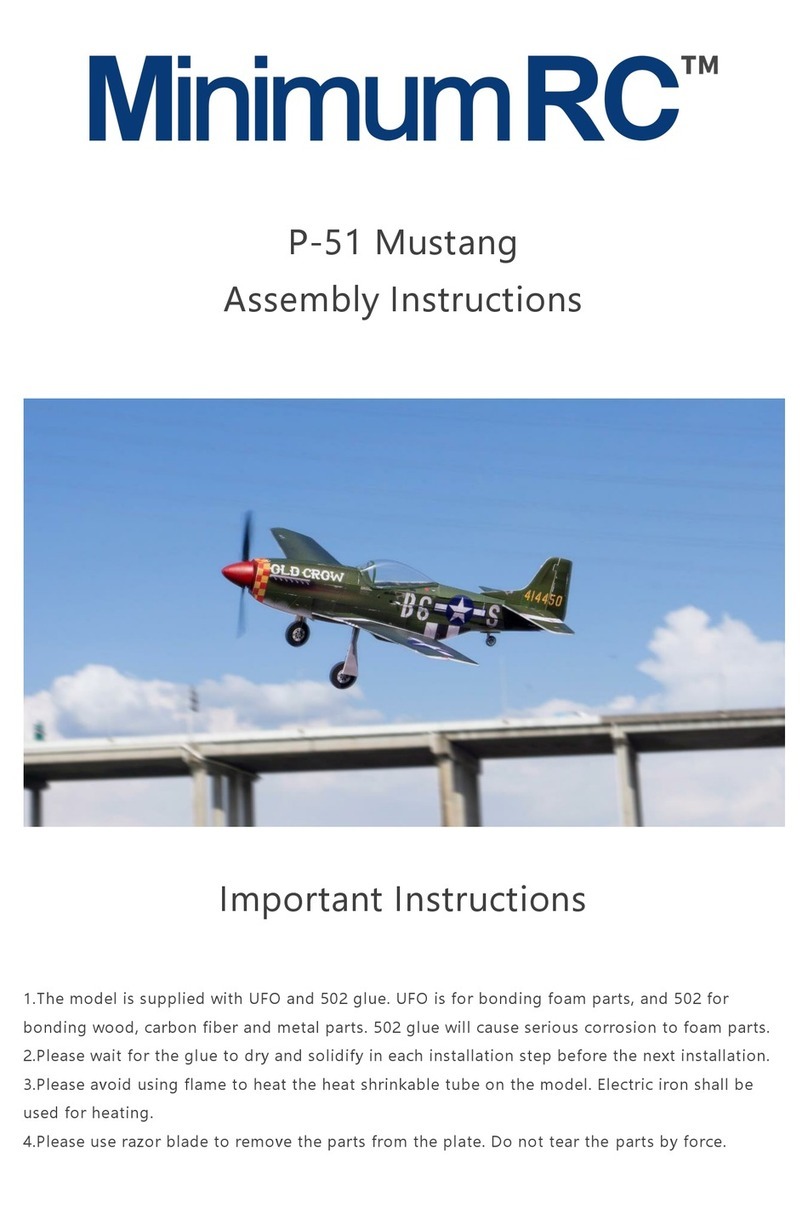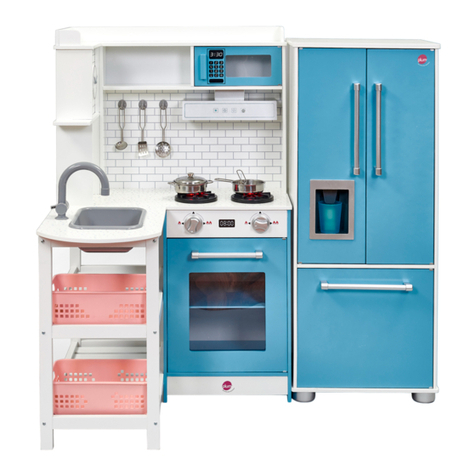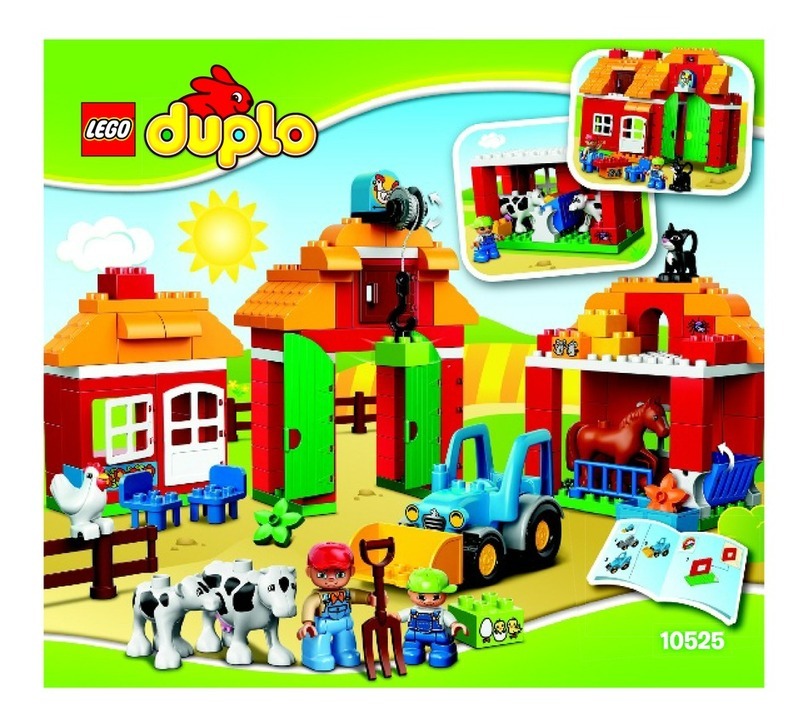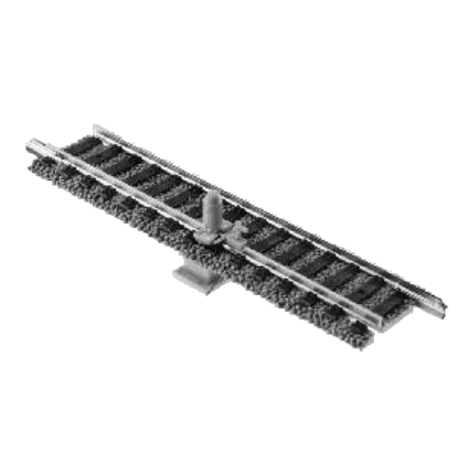MyLocoSound Valdora User manual

1
MYLOCOSOUND
LARGE SCALE DIESEL LOCOMOTIVE KIT
1.OVERVIEW
16mm to the foot scale model of an 0-4-0 Sugar Cane locomotive.
Easy glued assembly.
Heavy, high quality motor, gears and steel chassis for a long life.
Will pull dead G scale, live steam locomotives back to base.
Available with manual or radio speed control.
Customer needs to add:
oNine AAA rechargeable batteries.
oCouplers.
oPaint.
oOption to add drop in RCS radio control and MyLocoSound sound.
2. THE PROTOTYPE
Valdora is an 0-4-0 diesel locomotive
manufactured in Sydney by E.M. Baldwin
in 1965 as serial number 6/1258.1.
The locomotive worked its life at the
Moreton Sugar Mill in Nambour,
Queensland, Australia. It was often
coupled to its sister locomotive,
Maroochy and operated back-to-back
from one cab using multiple unit
controls.
Valdora weighs 8 tons and has a diesel
mechanical transmission. She was
modified several times, the addition of
an enclosed cab being the most
significant.
The kit depicts Valdora as she is today running on the tourist railway in Bundaberg, Queensland.

2
3. THE MODEL
The photo shows the Valdora kit finished in the prototype colours and an alternative colour scheme chosen
by a customer.
4. WHAT YOU NEED
We recommend the following be acquired to build this kit:
Selleys Interior Aquadhere or Craft glue for the mdf components.
Micro Kristal Klear adhesive for attaching the windows.
5 min Araldite glue
2mm and 1.5mm Allen keys for chassis assembly.
Dulux DuraMax spray undercoat and your choice of top coat colours.
A hobby paintbrush and a small pot of red paint for the lifting brackets on the buffer beam.
Any superglue to attached ABS 3D printed components to the mdf components.
Nine AAA rechargeable batteries. We suggest 900mah NiMh Fujitsu.
Whatever couplers you prefer. For Kadee, the buffer beams are pre-drilled for #779 sill
mounted pocket couplers.
Grease for the gears. Castrol LM or similar auto gear grease.
Elastic bands to hold components together while the glue sets.
Spray putty from auto accessory shops to make it easier to smooth 3D printed components.

3
4. BUILDING THE CHASSIS
If you wish to paint the flycranks and coupling rods then it is best to do so before assembly.
Use a 2mm Allen key to assemble the chassis as follows:
1. Using a flat surface, attach the four spacers to one side frame with the larger ends of the axle
bearings pointing outwards. Each spacer has a tapped hole in the centre. The holes in the upper
spacers need to point vertically. The holes in the lower spacers need to point horizontally.
2. Insert the motor support into the slot in that side frame with the motor pointing downwards.
3. Attach the other side frame to the brass spacers, ensuring that the motor support is fully engaged
in its slot. Check that the motor does not wobble. If it does then apply a drop of Loctite 601 to the
outside of the slots, let it seep into the gaps and then wipe off the excess after about ten minutes.
4. Attach the brass spacer to that side frame with the curved cut out facing downwards over the
motor.

4
Use the 1.5mm Allen key to assemble the wheels:
1. Attach a bevel gear wheel to the motor spindle so that it is pushed up against the motor case.
2. Thread an axle through the unpowered bearings. Place the wheels loosely onto the axle between
the frames. Place the fly cranks onto each end of the axle and lock them in place so that they
rotate freely with very little side play. Note that the grub screw engages with the flat surface of
the axle.
3. Repeat for the powered axle but include the bevel gear wheel between the wheels. After fixing
the fly cranks, fix the bevel gear wheel in place and adjust the motor bevel gear so that they are
fully engaged with the motor gear with a small amount of play between them.
4. Set the wheels in place using by tightening their grub screws on to the axle flats. The back to back
distance should be 41mm for 45mm gauge and 28mm for 32mm gauge.
5. Place a washer on each crank pin and then the coupling rod. Lock in place by snapping an e-clip
into the groove in each crank pin.
6. Apply Castrol LM or similar auto gear grease to the gear wheels and a light machine oil to the axle
bearings.
Important
Note that all but the smallest mdf components have a number etched on them which is
referred to in the assembly instructions below as #1, #2, etc.
Most of the components are reversible. Always assemble them so that the etched numbers
are facing inwards so that they are not visible through the paint.
The ABS plastic components have been 3D printed and will have fine ridges on their surface.
These should be sanded off. We recommend using Spray Putty from auto accessory shops to
obtain a smooth surface quickly.
If any part gets damaged during construction, let us know and we arrange a replacement.

5
5. BUILDING THE FOOTPLATE AND BUFFER BEAMS
The footplate and buffer beams are assembled as follows:
1. Glue the four chassis support strips (#13) to either surface of the footplate so that the hole in
the support strip align with the hole in the footplate floor (#10). Two support strips go on top of
each other at each end. Insert a 3mm bolt into both holes to ensure alignment until the glue has
set.
2. Glue the edges of the side frames (#11) to the same surface of the footplate (#10) as the
support strips. Ensure that the side frames are flush with the edges of the footplate. Rest the
slots in the buffer beams (#12) over the side frames to ensure that the spacing is correct.
3. Glue the buffer beams (#12) in place.
4. Glue the four lifting brackets into the slots in each buffer beam.
5. Sand any misaligned joints and then paint the assembled footplate and buffer beams. Primer
first and then the yellow (or your chosen colour) top coat.
6. Paint the four lifting brackets.
7. Cut out the warning stripes and attach to each buffer beam. You will need to use a hobby knife
to cut out the rectangular slots for each lifting bracket.
8. Paint the four 3D printed steps black.

6
9. Use Superglue or Araldite to attach the four steps. There are two slots in each buffer beam into
which the longer end of each step will fit.
10. Attach the footplate to the chassis using two 3mm bolts down into the chassis end spacers.
11. The buffer beams are pre-drilled for Kadee #779 or centre buffer couplers. Open holes in the
warning stripes to suit and attach your chosen couplers.
12. Insert a 3mm bolt through the hole below each coupler and into the lower chassis spacer. These
ensure that heavy loads will not pull the buffer beam off.
6. BUILDING THE ENGINE COMPARTMENT
The engine compartment is assembled as follows:
1. Remove the bolts from the fixing strip (#4) and glue it into the slots in each of the two side
panels (#3) and (#5) as shown. Ensure that the ends of the fixing strip are flush with the outer
side panel surfaces and that the components are perpendicular to each other. Rest a roof rib on
the other end of the side panels to ensure that the sides are parallel.
2. Glue the front panel (#1) to the front edges of the side panels (#3). Note that the fixing strip is at
the lower, flat end of the front panel.
3. Glue on the roof ribs (#2), one at the rear and the others equally spaced along the length of the
side panels.
4. Using superglue or 5 min Araldite, attach the radiator grill centrally to the front panel with the
lower hinge flush with the bottom and the wider end uppermost.

7
5. Take the brass wire and bend the sandpipes to fit in the two holes in each side panel and glue in
place using superglue or 5 min Araldite.
6. The sandboxes have holes in the filler cap and top
side for handles. Cut and bend the brass wire and
press them into the holes which may need to be
deepened with a small drill. If you prefer to have the
handles unpainted then do this after the sandboxes
have been painted. If you want the handles painted,
like the prototype, then inset the handles before
painting the sandboxes.
7. Use superglueor 5 min Araldite to attach the sandboxes to the engine compartment sides so
that the bottoms rest on the sand pipes attached earlier.
8. Sand any misaligned joints and then paint the assembled engine compartment. Primer first and
then the yellow (or your chosen colour) top coat. Also paint the engine compartment roof light
grey (or your chosen colour).
9. Paint the roof to the engine compartment and then attach using 5 min Araldite and hold in
place while setting using elastic bands on each rib. Make sure that the hole for the air cleaner is
nearest the front.
10. If you are using radio control then glue the air
cleaner into the hole in the engine compartment
roof.
11. Prime and paint the engine access hatches black (or
your chosen colour).
12. Using 5 min Araldite, glue the mesh to the back of
the hatches, trim the edges with a hobby knife and then glue both hatch assemblies to the
engine compartment sides.
13. Using a fine black pen, run it down the grooves in the radiator grill to simulate the air gaps.
14. Glue the short exhaust pipe into the side of the silencer and the long exhaust pipe into the top.
Paint and glue into the side of the engine compartment.

8
7. BUILDING THE CAB
The cab is assembled as follows:
1. Glue the fixing tabs (#23) into each side wall (#21) ensuring that the etched 21 numbers are on
the inside.
2. Glue the side walls (#21) to the cab front (#27) to the cab assembly. Ensure that the slots at the
bottom are fully mated with the fixing tabs (#23).
3. Glue the rectangular spacer (#22) to the side and front panels before their glue fully sets so that
it makes them square. Note that the two sides of the spacer are different lengths and it should
be orientated to match the side.
4. Glue the control panel top (#29) horizontally between the two walls and flush with the bottom
of the front windows.
5. Glue the control panel front (#25) vertically between the side walls and to the underside of the
control panel top (#29).
6. Glue the rear panel (#20) to the side walls (#21).

9
7. Glue the side doors (#24) to the inside of the rear wall (#20) ensuring that they are as far up as
they will go. They will be in contact with the underside of the spacer (#22). The engraved
numbers should face the back wall and the cut outs at the bottom of the doors should be to the
centre.
8. If you want the cab handrails to be
painted, like the prototype Valdora,
then bend and fit them now. If you
want them in unpainted brass then
fit them later. To make each
handrail, cut them to a length of
12mm more than the distance
between the holes and use needle
nose pliers to bend the ends to fit in
the holes each side of the cab door.
9. Sand any misaligned joints and then
paint the assembled cab. Primer first
and then the yellow (or your chosen
colour) top coat.
10. A self-adhesive control panel is included. Peel off the backing and attach it to the control desk
(#27 and #25).
11. Take each piece of glazing and peel the protective lining off. Glue each window in place ensuring
that they are pushed back into the rear of each opening. The front and back windows have a
lining which should be painted before being glued with Krystal Klear to each front and back
window. The side window also have frames which should be painted before being glued to the
side windows.
12. Finally paint the roof light grey (or your chosen colour) and use superglue or 5min Araldite to fix
the roof to the assembled cab.
8. INSTALLING A MANUAL SPEED CONTROL
The manual speed control module is fully assembled and tested before shipping. There are just two
things you need to do. First purchase nine AAA Ni-Mh batteries and insert them into the holders
underneath the module. Then place the module onto the footplate.
Insert the throttle spindle through the hole in the engine compartment roof and attach the air cleaner to
the spindle.
11. INSTALLING THE RADIO CONTROL AND SOUND
The radio control and sound module are fully assembled and tested before shipping. All you need to do
is to purchase nine AAA Ni-Mh batteries and insert them into the holders underneath the module. Then
place the module onto the footplate.

10
12. FINAL ASSEMBLY
1. Place the engine compartment onto the footplate and fix it loosely in place using two 3mm bolts under
the front. Then use superglue or 5 min Araldite to glue the engine compartment to the cab making sure
that the cab is correctly positioned on the footplate.
2. Connect the motor power leads plug and socket under the cab floor.
3. Use the two 3mm bolts provided, fix the cab to the footplate. Tighten all four bolts to secure the
engine compartment and the cab to the footplate.
13. RADIO CONTROL OPERATION
Always switch the transmitter on before the
locomotive.
The functions of the transmitter are shown in the
diagram.
The transmitter and locomotive have been “bound”
and set to work together before shipping. If the
locomotive fails to respond to the transmitter then
it is possible that “binding” has been lost. The
procedure to “re-bind” them is:
1. Turn the locomotive over and unplug the
motor wires.
2. Remove the four nuts which attach the body
to the cab floor.
3. You will find the binding plug on one pin of the
receiver. Attach it to all three pins as shown in the
photo.
4. Switch off the transmitter.
5. Switch on the locomotive.
6. Move the transmitter at least one metre away from
the locomotive, hold down engine start/stop button
and switch the transmitter on.
7. Keep the engine start/stop button held down until the
red light in the on/off switch stops flashing. That
shows that binding is complete.
8. Switch everything off.
9. Remove the binding plug and replace it on one pin of
the receiver so that you can find it next time.
10. Turn on the transmitter and then the locomotive and check that they are now communicating
correctly.
11. Reassemble the locomotive.
Binding plug in the storage position
on one pin.
Binding plug in the binding position
on three pins.

11
The throttle knob has a central indent which is the static position. Turning clockwise then sends the
locomotive forwards and anti-clockwise send it in reverse. If the throttle movement is misaligned then
you can recalibrate it as follows:
1. Turn the locomotive over and unplug the motor wires.
2. Remove the four nuts which attach the body to the cab floor.
3. Switch on the transmitter and rotate the throttle knob to its central position.
4. Switch on the locomotive. Red and green LEDs on the speed control module will flash quickly for
two seconds. Press the small grey button next to the LEDs during the two seconds. The green
LED will stay on.
5. Move the throttle fully clockwise and then
back to the centre. The green LED will go out
and the red LED will come on.
6. Move the throttle fully anti-clockwise and
then back to the centre. The red LED will go
out and throttle calibration is complete.
7. Reassemble the locomotive.
13. SOUND OPERATION
The soundcard has been set up to immediately operate using the most popular settings. If you are
happy with those sound settings then you need to nothing more.
However, it is also possible to change the horn, the engine and several other sounds according to your
personal taste. To make these changes you need any Sony™compatible TV remote control using the
buttons described in this section. We recommend the purchase of an Audiosonic or Home & Co TV
remote control from Kmart for about $12. Install batteries in your chosen remote control and then set
the code for the soundcard as follows:
For the Audiosonic:
1. Hold down the red on/off button and
press the TV button. Release both and
the TV light will stay on.
2. Enter 0188
3. The TV light will flash twice.
4. The remote control is ready for use.
For the Home & Co:
1. Hold down the red on/off button and the
TV button for five seconds. Release both
and the TV light will stay on.
2. Enter 0180
3. The TV light will flash twice.
4. The remote control is ready for use.
Note that the buttons on the remote control auto-repeat if held down. If you want a single event to
occur, like turning on the engine, then press button six and release it immediately. If you want to make

12
a large change in volume or tone then you can hold the button down to avoid the need to press the
button repeatedly.
The soundcard has two modes:
1. Setting mode in which you can select the sounds you want and can make adjustments to them.
2. Run mode in which the soundcard does its job on your railway.
All settings are done using the remote control and we will cover that first. So place the soundcard into
Setting mode by pointing the remote control at the soundcard or the receiver on the end of the flying lead
and press the Mute button. The LED on the soundcard will blink slowly and all sounds will cease.
Next press one of the keys on the remote control to change the sounds listed below. When you press a
button, the LED will start blinking faster. At any time, you can press the Mute button and then the button
you are changing to hear the sound you have selected and then press Mute again to turn it off. The options
are:
Power Button –Battery or Track Power. The soundcard can be used with battery powered, radio
controlled locomotives or with locomotives which are powered from the track (but not DCC). .
Press this button to change from one to the other:
1 beep –Battery powered radio control.
2 beeps –Track power. In this case, the soundcard will automatically turn itself off when the
locomotive has not moved for sixty seconds. Turning the track power up a little will
turn the soundcard back on.
Button 0 –Reserved for future use.
Button 1 –Horn 1. This is used to select the style of horn which suits your locomotive. Each of these
horns has an adjustable volume. Each time you press the 1 button the number of beeps will
change to indicate that the horn has been switched between the four available which are:
1 beep –Generic horn
2 beeps –Baguley Drewry horn (Default)
3 beeps –Barclay horn
4 beeps –Light Baldwin horn
If you wish to hear that horn, press the Mute button on the remote control and then button 1 to
start the horn and then again to stop it. While the horn is sounding, you can use the channel and
volume buttons to change the pitch and volume respectively.
See button 5 below for the ways in which the horns can be played.

13
Button 2 –Horn 2. This is used to select a second style of horn to use in combination with button 1 in a
two tone horn. Each time you press the 2 button the number of beeps will change to indicate that
the horn has been switched between the four available which are:
1 beep –Generic horn
2 beeps –Baguley Drewry horn (Default)
3 beeps –Barclay horn
4 beeps –Light Baldwin horn
If you wish to hear that horn, press the Mute button on the remote control and then button 2 to
start the horn and then again to stop it. While the horn is sounding, you can use the channel and
volume buttons to change the pitch and volume respectively.
See button 5 below for the ways in which the horns can be played.
Button 3 –Guard. This is used to select the guard’s sounds from the list below.
1 beep –Sounds a guard’s Acme Thunderer whistle.
2 beeps –Sounds “All aboard”.
3 beeps –Sounds “All aboard” and then the guard’s whistle. (Default)
Button 4 –Brakes. This gives you three braking options:
1 beep –No braking sounds required. (Default)
2 beeps –Automatic brake squeal whenever the locomotive comes to a halt.
3 beeps –Automatic airbrake release when moving off.
4 beeps –Automatic brake squeal whenever the locomotive comes to a halt plus automatic
airbrake release when moving off.
Button 5 –Horn Mode
1 beep –Button 1 and button 2 each play a single horn sound. The pitch of each horn can be
selected using the channel up/down buttons while that horn sounds. (Default)
2 beeps –Automatic two tone horn. Button 1 plays a single horn sound and then horn 2 briefly on
release. Button 2 plays a single horn sound and then horn 1 briefly on release.
Select one beep if you only want a single tone horn. Also select one beep if you want a European
two tone horn and to use two radio control channels to play tunes using buttons 1 and 2.
Select two beeps if you want a two tone horn using only one radio control channel. Note that
horns 2 and 4 are best for two tone use because of their short decay times.

14
Button 6 –Engine starting and stopping
1 beep –Manual. The engine will start automatically at power up. Pressing the button 6 will then
shut down and start up the engine using the starter motor (Default)
2 beeps –Automatic. The engine will shut down after one minute of no movement and will start
up again, using the starter motor, when the throttle is given a slight nudge.
3 beeps –Manual. At power up the engine will not start automatically but an airbrake release will
be heard to confirm that the soundcard is working. Pressing the button 6 will then start up and
shut down the engine using the starter motor.
Button 7 –Throttle Type. This will operate in three ways:
1 beep –Manual notch up. Revs increase proportionally to the speed. (Default)
2 beeps –Automatically revs up to notch 5 to move off with engine revs twice tickover.
3 beeps –Automatically revs up to notch 8 to move off with revs three times tickover.
It is important to tell the soundcard when your loco starts moving. Do this by slowly increasing the
throttle until the loco is just about to start to move. Then press the power button on the remote
control. This tells the soundcard the voltage at move off.
Button 8 –Engine Type. There are two types of engine to choose between:
1 beep –Generic industrial diesel. (Default)
2 beeps –Ruston & Hornsby four cylinder industrial diesel
Button 9 –The Operating Mode. There are three operating modes available:
1 beep –Indicates manual mode. In this mode all sounds are triggered according to the above
settings. The whistle will sound for as long as its button is pressed. (Default)
2 beeps –Indicate simple automatic mode. This is designed for controllers which have no function
buttons, as is often the case with track power, or at exhibitions, etc. where you don’t
want to operate manually. The whistle will sound once automatically when the loco
moves off and then once more three times a minute when the loco is in motion. A reed
switch can be placed under the loco and be connected to the F1 terminal to make the
whistle sound when the loco passes over a magnet. Another reed switch, connected to
the F2 terminal, can be used to trigger the second horn which will turn on when crossing
a magnet and then off at the next magnet.

15
You can change these settings whenever you wish and those changes will be effective immediately.
Holding down the 0 button until you hear five beeps will cause the soundcard to reset itself back to its
factory defaults.
Channel Up/Down –Motion Sensitivity. When the loco is in motion, the soundcard changes the sounds
according to whether the loco is accelerating, coasting or slowing down. If you find
that the sounds are changing too frequently then press Mute and then the Channel
Up button. You will hear one to five beeps. The higher the number of beeps, the less
sensitive the soundcard is to changes of motion. Use the Channel Down button to
reduce the number of beeps and make it more sensitive to changes in motion.
Valdora Instructions.doc 1/11/18 Version 1
For more information, please visit the web site at www.mylocosound.com or e-mail
Copyright © 2013-8 MyLocoSound Pty. Ltd.
Table of contents
Popular Toy manuals by other brands

Magnificent Flying Machines
Magnificent Flying Machines SE5A Assembly manual

Bole Laser Craft
Bole Laser Craft Grange Farm Tipper Wagon Assembly instructions

Aviation Design
Aviation Design Mini Diamond Assembly manual
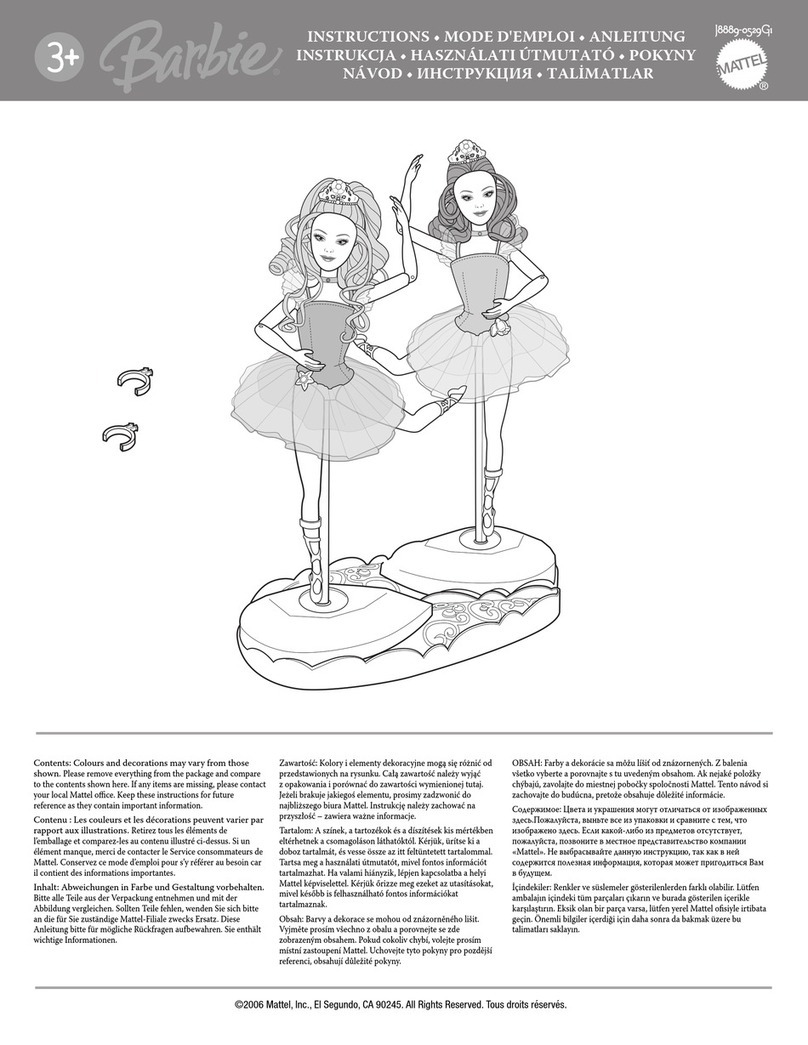
Mattel
Mattel Barbie J8889 instructions
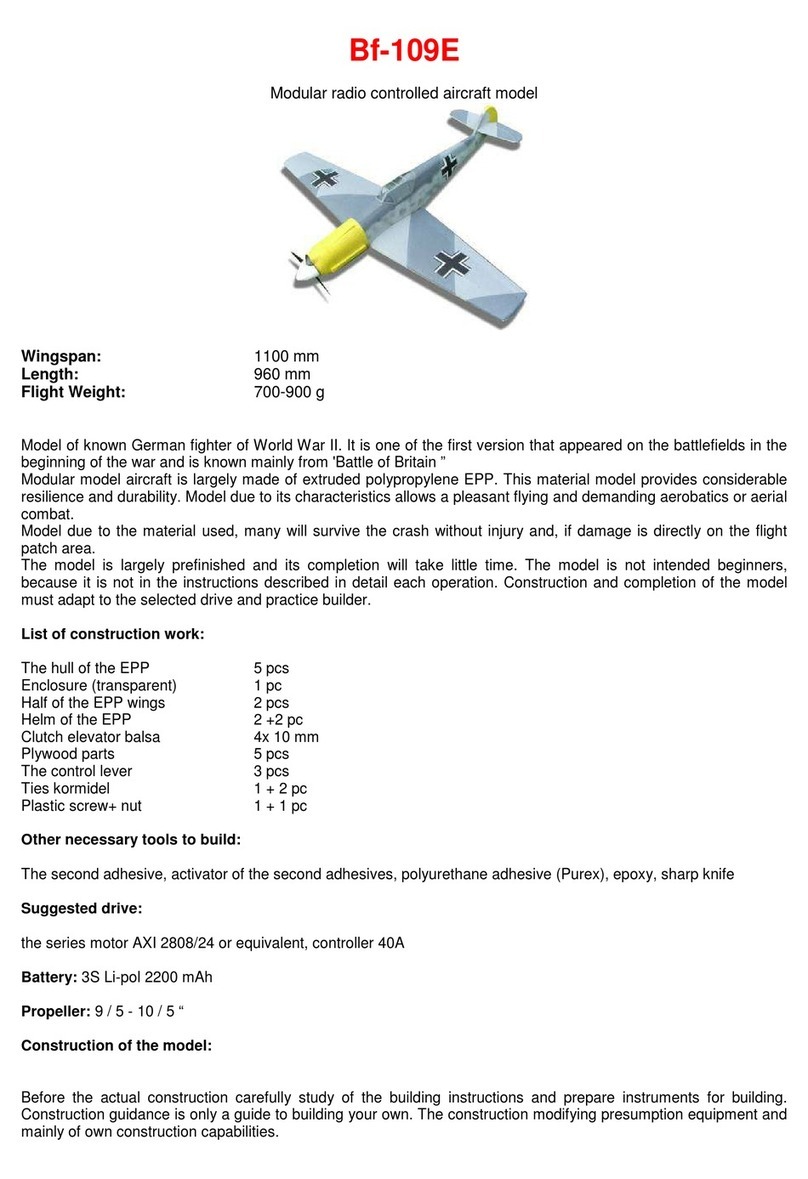
LM model
LM model Bf-109E user manual
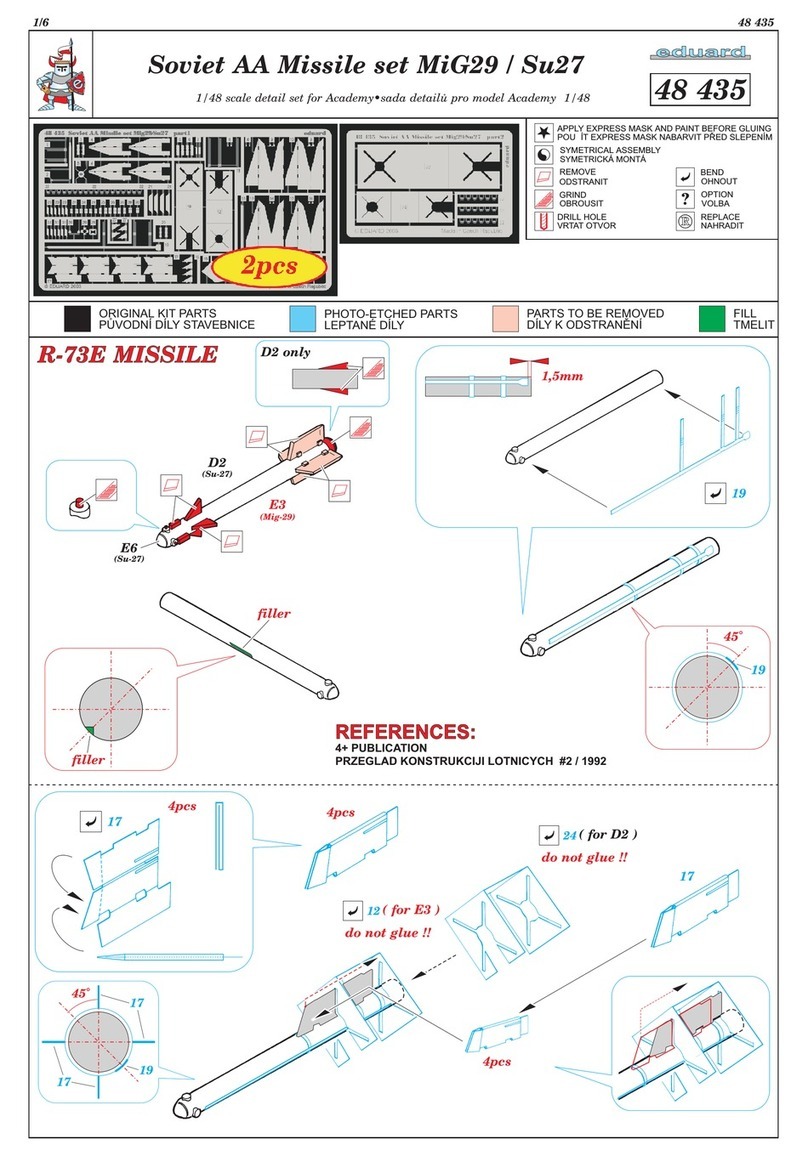
Eduard
Eduard Soviet AA Missile set MiG29/Su27 quick start guide

Pro Boat
Pro Boat Stealthwake 23 troubleshooting guide

Stevens Aero Model
Stevens Aero Model CAP 232 manual

V-tech
V-tech Cora The Smart Cub - Pink user manual
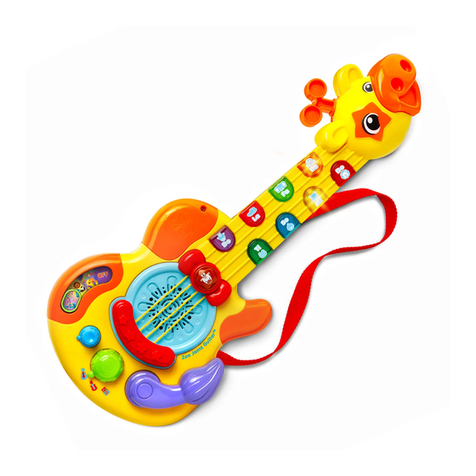
V-tech
V-tech Zoo Jamz Guitar instruction sheet
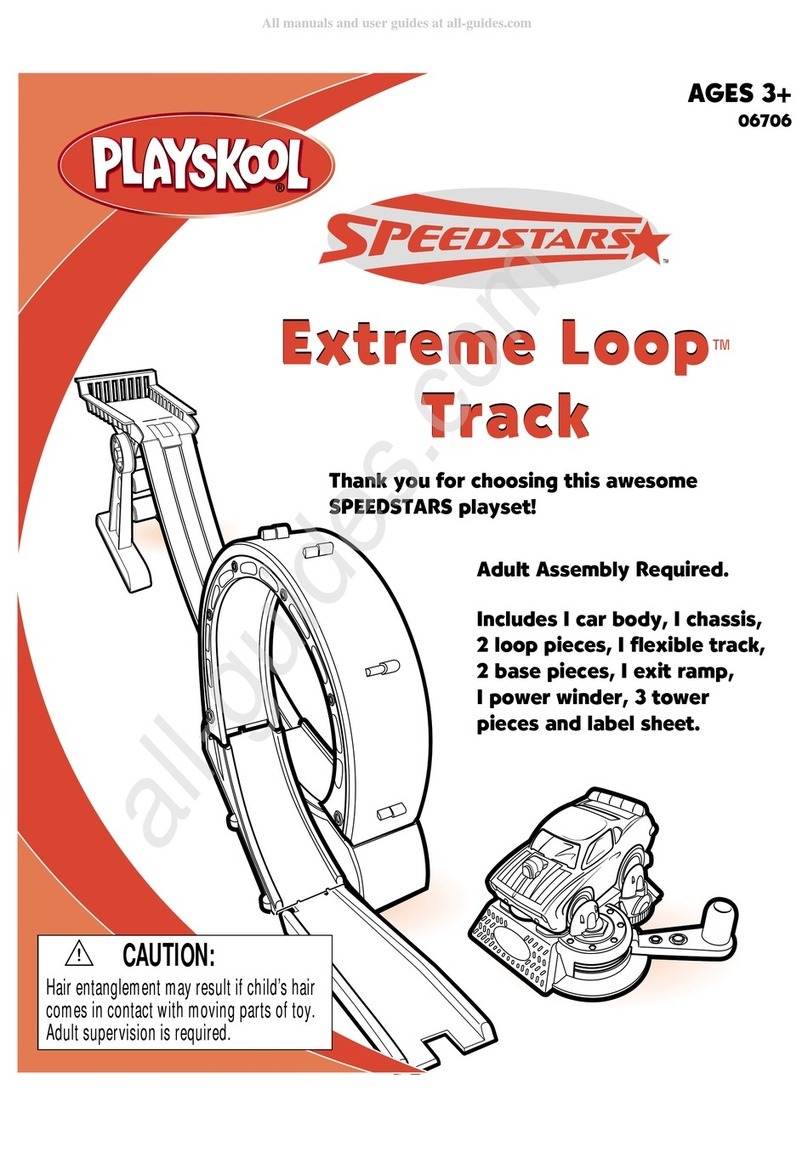
Playskool
Playskool SPEEDSTARS Extreme Loop Track 06706 quick start guide
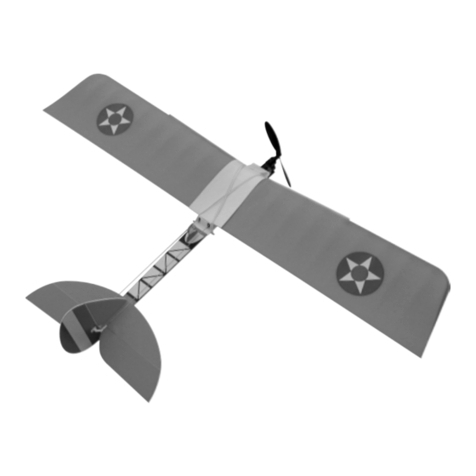
WATT AGE
WATT AGE Mini-Max EP instructions
